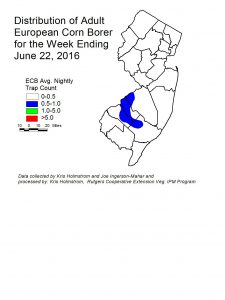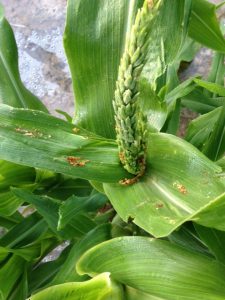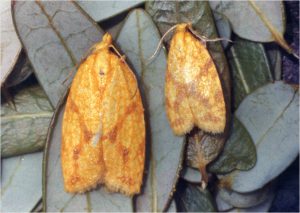Sweet Corn
 European corn borer (ECB) moth catches are very low now. The first flight is largely over, and as is common, feeding signs in the field have increased as eggs hatch. Present adult activity is largely confined to Gloucester and parts of surrounding counties (see ECB map). Larval feeding ranges from single digits to 40% in areas where IPM personnel are operating, although many plantings still have no detectable feeding at all. The highest feeding percentages are currently in Mercer and parts of Morris counties. Be sure to begin monitoring plantings for ECB feeding while they are still in the whorl stage. Consider treating when the number of infested plants in a 50 plant sample exceeds 12%. Feeding in the whorl stage will appear as numerous small holes (called “shot-hole”) on leaves, with damage present on consecutively younger leaves. As plants progress to pre-tassel and beyond, droppings and larvae may be found in or on the emerging tassels (see
European corn borer (ECB) moth catches are very low now. The first flight is largely over, and as is common, feeding signs in the field have increased as eggs hatch. Present adult activity is largely confined to Gloucester and parts of surrounding counties (see ECB map). Larval feeding ranges from single digits to 40% in areas where IPM personnel are operating, although many plantings still have no detectable feeding at all. The highest feeding percentages are currently in Mercer and parts of Morris counties. Be sure to begin monitoring plantings for ECB feeding while they are still in the whorl stage. Consider treating when the number of infested plants in a 50 plant sample exceeds 12%. Feeding in the whorl stage will appear as numerous small holes (called “shot-hole”) on leaves, with damage present on consecutively younger leaves. As plants progress to pre-tassel and beyond, droppings and larvae may be found in or on the emerging tassels (see  photo at right). Any planting remaining at or above threshold as it proceeds to full tassel should be treated, as this is the last stage at which ECB larvae will be exposed and vulnerable to insecticidal sprays. Insecticides that are acceptable in organic production include the spinosyn based material Entrust (IRAC-5) and Dipel (IRAC-11a). The 10G formulation of Dipel is particularly useful when granules can be dropped or broadcast such that they get into the whorls of corn plants. Other effective insecticides include Coragen (IRAC 28), and the synthetic pyrethroids (IRAC 3). See the 2016 Commercial Vegetable Recommendations Guide for a more complete list of insecticides. [Read more…]
photo at right). Any planting remaining at or above threshold as it proceeds to full tassel should be treated, as this is the last stage at which ECB larvae will be exposed and vulnerable to insecticidal sprays. Insecticides that are acceptable in organic production include the spinosyn based material Entrust (IRAC-5) and Dipel (IRAC-11a). The 10G formulation of Dipel is particularly useful when granules can be dropped or broadcast such that they get into the whorls of corn plants. Other effective insecticides include Coragen (IRAC 28), and the synthetic pyrethroids (IRAC 3). See the 2016 Commercial Vegetable Recommendations Guide for a more complete list of insecticides. [Read more…]


